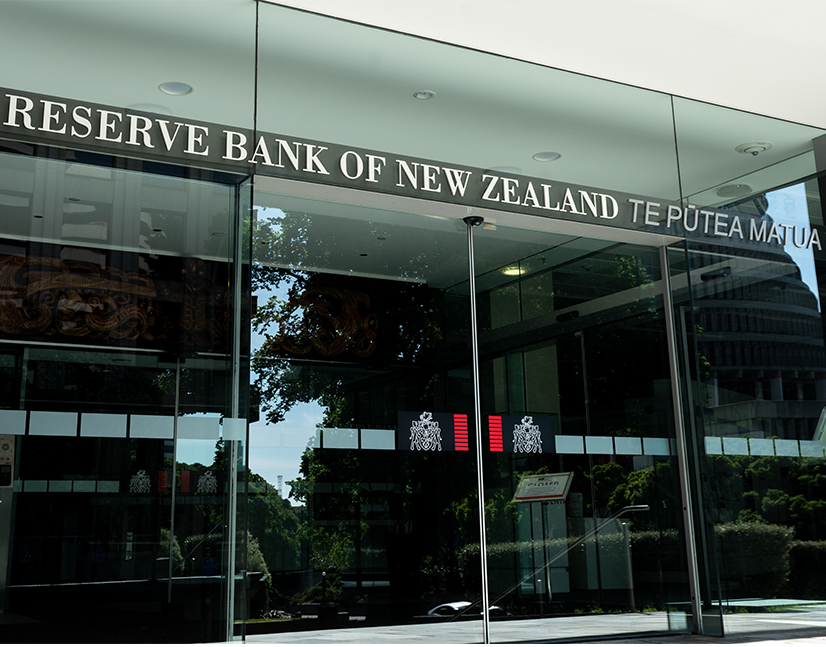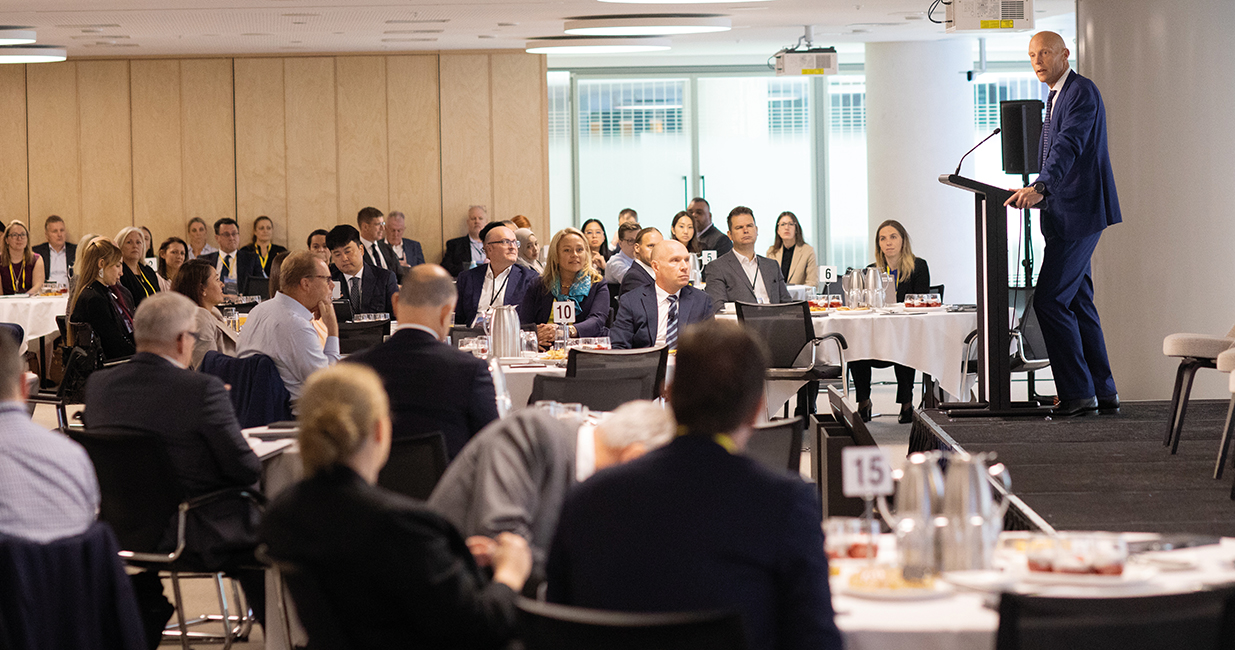
Solid foundations for an uncertain future
The 2023 Commonwealth Bank of Australia Global Markets Conference brought international investors to Australia at a fascinating juncture for the local economy and the fixed-income asset class. While the general view remains that the central bank hiking cycle is close to played out, the market is also coming to terms with the real consequences of a higher for longer environment. Australia is not fully insulated against cold global winds but it also has reasons for optimism.
The conference took place in Sydney on 23-25 October before invited delegates travelled to Western Australia for a state update on 25-27 October. Sessions covered a raft of relevant issues from geopolitics to the local credit market, with time also devoted to the growing sustainable finance market and to New Zealand. The new governor of the Reserve Bank of Australia, Michele Bullock, also gave her first public address at a gala dinner included in the event programme.
Introducing the conference, Andrew Hinchliff, group executive, institutional banking and markets at Commonwealth Bank of Australia, highlighted the febrile environment in which the discussions were to take place and the extent to which the future is unknown.
He said: “While it is generally, if not universally, accepted that the post-pandemic phase of rapid central bank hiking is at least close to its peak, the world is waiting with baited breath to see whether an almost unprecedented degree of tightening will contain inflation without decimating economic growth.”
AUSTRALIA’S ECONOMIC AND MARKET PERFORMANCE: A HIGH-WIRE ACT SEEKING A SOFT LANDING
Australia is not alone in its recent experience of rapidly tightening monetary policy from a battle against inflation that may be on track but is far from won. The path to a soft landing – of rates not going higher than they need, and perhaps increasing by less than some other central banks have imposed, while still doing enough to bring inflation back to target – is not an easy one. The fact that many believe it is possible at all, and that capital markets have remained functional and well supported throughout, is a basis for optimism in and of itself.
The rapid hiking cycle of 2022-23 is a near-universal global phenomenon but the Australian experience is no less dramatic as a result. Borrowers, investors and traders have been forced to respond to an environment driven by a cash rate that has increased by more than 400 basis points in barely a year. At the same time, risk events have continued to rock the world, and capital markets.
“As central banks try to thread the needle of getting inflation under control while managing economic growth and financial stability, markets have continued to be volatile – which has driven a fixed-income bear market of historical proportions,” said Commonwealth Bank of Australia (CBA)’s group executive, institutional banking and markets, Andrew Hinchliff. “All this is interspersed with significant geopolitical uncertainty: the ongoing war in Ukraine and, most recently, the tragic events unfolding in the Middle East.”
Adam Donaldson, executive director, macro strategy at CBA, echoed the significance of the bond bear market that has accompanied the run up in rates, suggesting that its severity surpasses even that of 1994 as the greatest in a generation. “We also don’t yet know if we are coming to the conclusion of this period – the last few months have continued the pain,” he added.
The global market tone certainly weakened in the second half of 2023, with worrying – if not catastrophic – global economic data and the latest wave of geopolitical turmoil supplanting a broadly optimistic mood from earlier in the year. Markets have gradually come to the conclusion that the war on inflation may be protracted even if it is ultimately successful.


This view received succour at the keynote speech of the CBA conference, from new Reserve Bank of Australia (RBA) governor, Michele Bullock, on 24 October. Viewed as hawkish at the margin, Bullock was clear that the RBA would not hesitate to hike further if it felt conditions demanded it. The central bank backed its words with actions in short order, following a slightly higher than expected Q3 CPI print the day after Bullock’s speech with a rate hike on 7 November.
The view throughout the CBA event was that monetary conditions and the outlook are on a knife edge. “Taking the cash rate and mortgage rates then discounting with break-even inflation expectations, our assessment is that policy is roughly as tight as it was in 2010 and not as tight as it was in 2007-08,” Donaldson suggested. “In other words, policy has moved to the tight side but is not overly tight. The question we are all asking is whether the RBA has done enough, and at this stage our view is that it is touch and go.”
A WORLD OF RISK
The context is a world full of risks. The news cycle has been dominated by the Israel-Gaza conflict, though in this case CBA’s strategists suggest the relative calm with which global markets have responded to the latest flaring of tensions in the Middle East may be appropriate – for the time being, at least.
Vivek Dhar, commodity strategist at CBA, argued that even when there is conflict in the Middle East the near-term premium on oil pricing typically recedes if there is not a physical impact on oil supply. This has been the general expectation since the war began on 7 October – and, by late the same month, physical oil supply had not been affected.
The situation is clearly still fraught, however, with the possibility of regional and global contagion. “The risk is that the conflict extends further – in particular to involve Iran, which of course is a direct oil producer,” Dhar continued. “Iran has actually increased its oil exports by about 1 per cent of global supply in the past 12 months. But the major market concern is about Iran’s control of the Straight of Hormuz, which has the transit of about 15-20 per cent of world oil supply.”
Of less headline interest but potentially greater impact to the Australian economy, China’s slow-rolling economic downturn shows little sign of ending. In particular, Joseph Capurso, CBA’s head of international and sustainable economics, explained, China is not following its “usual playbook” of stimulus via big, debt-funded infrastructure projects – which has been a very big positive for Australia in recent decades.
The reason is that Chinese local and regional governments have historically implemented these projects, but this level of the administration is highly indebted in particular because of costs entailed by the pandemic. A collapse in property tax revenue then and since has only exacerbated the situation.
Capurso added: “It has been reported that the Chinese central government may step in to finance local infrastructure projects. If this was to be the case it would be a big positive for the Chinese economic outlook, commodity prices and the Australian dollar. But the big picture is that, overall, Chinese growth potential is falling – and it is doing so, as is the case in other countries, because of demographic trends.”

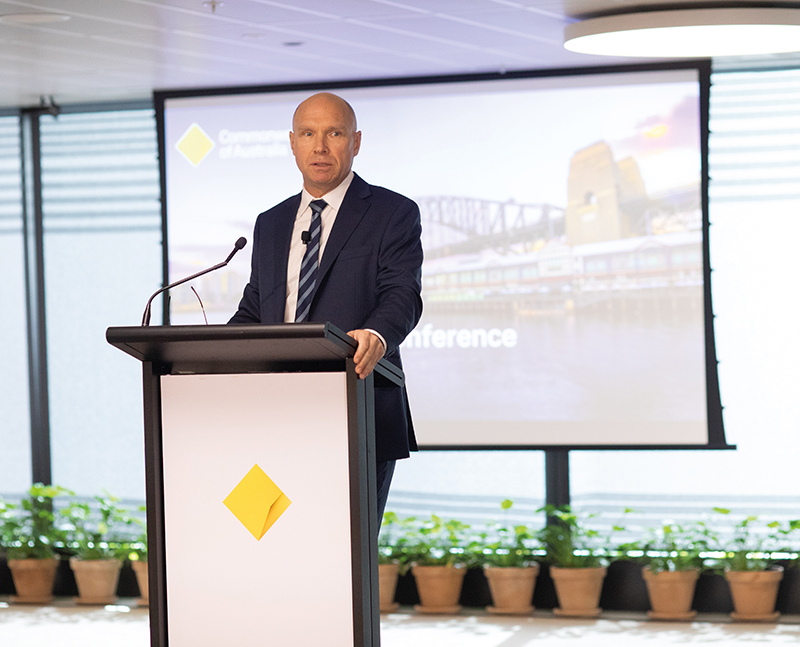
DOMESTIC PICTURE
The domestic picture is hard to interpret even in the absence of external shocks. The RBA has hiked the cash rate somewhat less than many of its peers, including its nearest neighbour – the Reserve Bank of New Zealand – and the US Federal Reserve. While inflation has fallen it is, at 5.3 per cent annualised for Q3 2023, still well above the RBA’s 2-3 per cent target range. The path to inflation reduction with the least economic collateral damage is a narrow one.
Stephen Halmarick, CBA’s chief economist, said: “The RBA wants to get inflation back to target, in a relatively timely way, without doing too much damage to the labour market. This is a good goal to have but the market is quite skeptical that it can be achieved. The question is how long we need for the RBA’s theory to play out, to see if it achieves its desired outcome. We suspect we have a little further to go to really test it.”
At its heart, the point of uncertainty is the status of the relative resilience of the Australian economy, and particularly the household sector, in the face of much higher rates. In a positive read of the scenario, this represents the potential for a soft landing: that households will be able to ride out the period of higher rates for long enough that inflation can be controlled. The flip side of the coin is the possibility that inflation cannot be brought back into the target band without further suppressing household demand.
The resilience story is holding up so far. CBA’s chief executive, Matt Comyn, noted that the bank’s latest numbers represent a continuation of the trends it has witnessed over recent months: more household resilience than it might have expected after 400 basis points of rate rises and only limited signs of consumer deterioration.
“There is definitely a feeling of some softening, but this is to be expected,” Comyn added. “While we can’t lose sight of the fact that some people are making very difficult choices and trade-offs, the reality is that only a very low proportion of our customers is in need of financial assistance.”
On the other hand, higher rates are undoubtedly having an impact. “It doesn’t matter which data set we look at right now – it is clear the consumer is slowing,” said Gareth Aird, head of Australian economics at CBA.
Total nominal spending in the economy has eased and total real spending growth – which overlays inflation – is only just more than 1 per cent. This outright figure incorporates the impact of strong population growth; real per capita spending is actually down by almost 3 per cent. The bottom line is that the average household in Australia is now consuming less, in a volume sense, than it was four months ago.
Aird argued that this sort of decline in household spending could typically be expected to cause loosening in the labour market. But the relatively small increase in unemployment to date – about 1 percentage point, after removing noise in the data – is “something of a surprise”.
But Aird added: “However, when we dig beneath the surface it seems the Australian labour market is loosening a little more than the unemployment rate alone suggests. Underemployment is up by 4 percentage points in the past year, for instance, while job advertisements have come down pretty swiftly over the past six months or so and the number of applicants per job has climbed. For workers, the market has become more competitive as the economy has slowed.”

FUTURE HOPES
There are reasons to hope the RBA will be able to bring inflation back to the target range without laying waste to demand and, therefore, economic growth. Perhaps the biggest factor is a structural advantage deriving from the nature of Australia’s mortgage market. The overwhelming majority of borrowers have variable-rate loans, which makes them directly exposed to movements in the cash rate.
“The RBA gets more bang for its buck when it raises and lowers rates than other central banks because the Australian cash-flow channel is much more potent,” Aird explained. “All the major central banks other than the BOJ [Bank of Japan] have tightened rates, but Australia has not gone quite as far. One of the reasons for this is the nature of our cash-flow channel. Australian mortgage rates on average have gone up by more than anywhere else in a shorter amount of time, despite the fact that the RBA hasn’t taken the cash rate as high as other central banks.”
Another factor that may allow the RBA to control inflation even with a relatively lower cash rate than some of its peers is that Australian central bank policy is not having to also compensate for a government budget position that continues to act as a de facto fiscal stimulus.
“The federal budget position is on a really good track,” Halmarick told conference delegates. “We are running a budget surplus of more than 0.5 per cent, which is a massive contrast with the US and, really, most of the rest of the world. This is likely to be a windfall but the good news is that the government isn’t just spending it.”
Mitch Grosser, CBA’s head of trading, added: “The RBA and other global central banks are trying to reduce the size of their balance sheets and this is offset in Australia by slightly lower issuance requirements. But it is a different picture offshore – the US and UK are still running deficits of 5-6 per cent of GDP, for instance. Having one foot on the fiscal accelerator and the other on the monetary brake is going to produce further volatility and some unintended consequences.”
There are also reasons for a positive outlook on Australia in the medium-to-long term. One of the biggest is the investment pipeline. Belinda Allen, senior economist at CBA in Sydney, noted that Australia’s federal and state governments have responded to a period of falling behind provision of the infrastructure required by a growing population by initiating a dizzying series of major projects, particularly in the transport sector.


The country also finally has clarity on policy direction supporting the net zero transition, which is just starting to catalyse an expected wave of investment in renewable energy infrastructure.
This comes with challenges in the near term but should also deliver growth in the next phase of the cycle and lay the ground for a better future trajectory. Allen explained: “Infrastructure investment is really important for productivity and therefore for controlling inflation over the medium term. The problem right now is that we are facing significant capacity constraints in the construction sector with a lot of federal and state government projects going on at the same time.”
MARKET IMPACT
The overall outlook, therefore, might best be described as an uncertain present but a positive future. This seems to be reflected very closely by fixed-income market trends and sentiment. For instance, Donaldson revealed that CBA has had a relatively difficult job persuading global investors of its view that Australia has a relatively steep curve that should be attractive for longer-duration investment.
“The message I have heard from offshore investors is that there is a reluctance to be too exposed to the duration story in Australia,” he said. “There is more interest in the US, where the view is that there could be significant rate cuts and thus bond performance – as opposed to Australia, where yields are a little lower. Investors aren’t convinced that the RBA is done on rate hikes.”
This could represent an opportunity that has not yet been fully exploited as, in other respects, the fixed-income asset class is coming back into vogue after many years in the wilderness. Grosser noted that the US Treasury market had enjoyed 36 consecutive weeks of net inflows by the time of the CBA conference, which he said supports the view that yield is getting ever closer to a level at which it makes sense for global investors to get involved.
“It is the same story for bond yields relative to equity valuations, which point to the potential for further rebalancing into fixed income,” he added.
There is certainly a good level of baseline support for Australian bonds. Anna Hughes, chief executive at the Australian Office of Financial Management (AOFM), told conference delegates that while offshore ownership of Australian Commonwealth government bonds (ACGBs) has been fairly stable at roughly 45 per cent, the value of these holdings has increased significantly – in line with the larger stock of outstandings. Excluding RBA holdings, around 70 per cent of ACGBs are held offshore.
The issuance outlook should support performance in the sovereign curve. “Over recent years there has been consistent downward revision of our forecast net debt position. This is good news for the Australian taxpayer but not such good news for investors and traders seeking supply from the AOFM,” Hughes said.


This highlights an important trend in Australian high-grade issuance. While the sovereign’s call on markets has eased, at least in net new money terms, there has been a flood of issuance at state level – driven by the pandemic response and now by infrastructure commitments.
“The issue at state level is that the taxes states rely on are much softer: consumer spending has been weaker and housing turnover has been low,” Halmarick told conference delegates. “At the same time, the states are facing a big increase in cost – particularly for the provision of infrastructure. This means a dramatic shift from a market dominated by sovereign issuance to state government issuance, and it is hard to envisage this changing any time soon.”
In the bond market, however, this could actually be a boon for the semi-government sector – in the sense that more issuance lays the groundwork for more liquidity. There is certainly no sign of supply outstripping demand.
“I think markets have been pretty good, all things considered, over the past 12 months,” said Paul Kelly, head of markets at Treasury Corporation of Victoria. “We have placed about A$14.5 billion in the past three months and the spread of where this money has come from has been good. Bank balance sheets are still taking down about half our programme, but our bonds are also attractive to official institutions – overall, a lot of investor types are engaged with our programme.”
Susan Buckley, Queensland Treasury Corporation’s head of funding and markets, added: “We are getting good volume away at good pricing. It was pleasing to see a broad spread of real-money investors in our most recent syndication – the 2036 bond. These investors are, understandably, quite selective on price especially in volatile environments. But we are quite confident their demand will be there especially as the interest rate outlook turns.”
Meanwhile, Adrian David, senior credit analyst at Macquarie Asset Management, said the same fundamentals – of robust demand driven by higher outright yield – also apply in the credit sector. “For the first time in a while, fixed income actually offers good returns,” he suggested. “The years when credit was offering 2-3 per cent really did not provide an attractive environment other than from a defensive perspective. We now view fixed income as a destination for capital, because it offers returns that are appealing on a historical basis.”
NO DEVIATION FROM INFLATION FOCUS, NEW RBA GOVERNOR CONFIRMS
The new governor of the Reserve Bank of Australia, Michele Bullock, used her first public speech in the role to affirm its laser focus on inflation – noting that the other aspects of the bank’s mandate may be subordinate to, or have complementary outcomes with, inflation direction. Analaysts and markets interpreted the speech as at least somewhat hawkish – and it preceded a November rate hike following a higher-than-expected CPI print.

Bullock’s speech – which took place on 24 October as part of Commonwealth Bank of Australia’s Global Markets Conference – was entitled Monetary Policy in Australia: Complementarities and Trade-Offs. In it, Bullock noted that the Reserve Bank of Australia (RBA) is adopting a recommendation of the recent independent review of the central bank to make the full employment aspect of its mandate “more explicit” but also argued that this would not mean deprioritising inflation.
“Over time, low inflation and full employment go hand in hand,” Bullock explained. “Low and stable inflation is a prerequisite for strong and sustainable employment growth because it creates favourable conditions for households and businesses to make decisions about how to use their resources. It is also true that when unemployment is persistently away from full employment, inflation will persistently deviate from its target. So our two objectives are complementary over the longer term.”


This is “often” also the case even in the short-to-medium term – the period of “between a few quarters and a few years” that is the typical focus of monetary policy, according to Bullock. When economic cycles are being driven “mainly by strengthening or weakening demand”, she added, employment and inflation tend to rise and fall together.
But the present set of circumstances may be an exception. Bullock added: “It is only when faced with negative supply disruptions that there may be a need to think about potential trade-offs. For example, disruptions to energy supply or natural disasters can cause inflation to rise above target at the same time as unemployment increases.”
IMPRECISE NAIRU
Perhaps the biggest difference between the inflation and employment aspects of the RBA’s mandate is that the former is a clearly defined, quantitative target – 2-3 per cent on average over time – but there is no enumerated target for unemployment. This is inevitable given the imprecise nature of employment data and the significance of related factors.
For instance, Bullock described the non-accelerating inflation rate of unemployment (NAIRU) as one way of trying to gauge what labour market outcomes are currently consistent with the definition of full employment. But she added that it “can only be a starting point” because it is estimated imprecisely, especially in real time, and does not capture all relevant information.
“Our assessment of what labour market conditions currently constitute full employment therefore incorporates a lot of judgement. Other factors – such as how broader measures of underutilisation are evolving relative to unemployment, trends in wage-setting mechanisms and mobility and, importantly, wage and inflation outcomes – are all part of our considerations.”
Bullock’s comments on economic conditions and household stress seemed to support the view that the decision about whether or not to further raise the cash rate would be a close one but perhaps weighted very slightly in favour of hiking. For instance, the governor explained in some detail why the RBA does not believe restrictive policy designed to curb inflation is mutually exclusive with also achieving its employment goal – at least not in the long term.

“Some commentators have expressed concern that a more explicit employment objective would mean we deprioritise inflation. Others are worried that the board has unduly prioritised lowering inflation over preserving jobs,” Bullock said. “While it is true that there can sometimes be a need to consider how to balance these objectives, there are more complementarities between them than is often recognised.”
Bullock added: “Maintaining low inflation gives households and firms more certainty when planning for the future. It also facilitates a better allocation of resources. Both of these, in turn, support increased investment and productivity growth.”
The RBA also appears to believe there is capacity to raise rates if required, as Bullock suggested the bulk of Australian households have so far been resilient to the impact of higher interest rates.
In particular, she noted that “the spare cash flow of renters has, on average, risen a little as high inflation and rising rents have been more than offset by growth in income”. Households with a mortgage have experienced a “significant decline in spare cash flows”, though even here the blow has been cushioned to some extent by higher wages.
While acknowledging that “the pressure facing indebted households is much greater for a small group of highly leveraged borrowers than for those with more modest levels of debt”, Bullock implied that this would not stay the RBA’s hand should it determine that higher rates are necessary.
She said: “We speak directly to organisations that provide debt advice and mental health services and are hearing that many households are under significant financial stress. We discuss this regularly in board meetings. At the same time, the bank’s statutory objectives are economy-wide outcomes, and our key tool – the interest rate – is a blunt one. The board recognises the effects of monetary policy on the welfare of different individuals, but it must set its policy to serve the welfare of Australians collectively.”

FINANCIAL STABILITY
The other aspect of the RBA’s mandate Bullock discussed was that the central bank should “contribute” to financial stability. Here, she acknowledged that while the financial stability objective is typically “intrinsically linked and complementary to [the RBA’s] objectives for inflation and employment”, current circumstances are somewhat unusual.
Indeed, the RBA board concluded at its October meeting that risks to financial stability are currently high. However, Bullock said monetary policy is not the right tool to manage the situation.
Noting that the RBA board will “usually prioritise its inflation and full employment objectives” on occasions when they conflict with financial stability, Bullock said this approach “reflects the principle that other agencies and their tools – most notably APRA [the Australian Prudential Regulation Authority] – are better placed to prevent the build-up of financial vulnerabilities than monetary policy [and] it recognises that consistently achieving multiple objectives requires multiple tools”.
EYES ON ESG CREDENTIALS
The volume of sustainable debt supply continues to grow in Australia. But the pace of growth has slowed – just as capital markets start to confront the scale of the local energy transition financing task. Investors at the Commonwealth Bank of Australia Global Markets Conference are keen to see more labelled bond supply in the context of an ever-growing focus on sustainability.
Australian environmental, social and governance (ESG) labelled bond issuance had reached a record-breaking high of A$20.5 billion (US$13.7 billion) as at 23 October 2023, according to Lauren Holtsbaum, head of ESG debt capital markets at Commonwealth Bank of Australia (CBA). However, as a proportion of total Australian dollar issuance, ESG labelled supply accounted for just 9 per cent of aggregate deal flow by mid-October, compared with 14 per cent in 2021.
Development has also not been consistent across labels and sectors. According to Holtsbaum, supranational, sovereign and agency (SSA) and semi-government issuers comprise 83 per cent of Australia’s ESG market in the year to date. At the same time, the green use-of-proceeds (UOP) label “continues to dominate”, comprising 57 per cent of Australia’s ESG-aligned bond market. Its social counterpart remains a “relatively small part of the market”, at 15 per cent, Holtsbaum revealed.
Increased supply of social bonds from the corporate world would be “great for diversification” commented Ben Squire, executive director and head of credit research, Asia Pacific at UBS Asset Management. However, he added that growth continues to be more straightforward in the green space, where measurement and alignment of objectives is easier to deliver.
There is an expectation that the labelled bond market will continue to grow. Kylie-Ann Richards, deputy chief investment officer at Fortlake Asset Management, said the significance of the low-carbon transition means there is also “an increasing focus on assessing ‘brown’ or conventional bonds based on issuers’ ESG criteria and then making investment decisions taking this assessment into consideration”.
Squire added: “Investing in bonds is not just about labelled products, because first we must like the credit scoring and overall ESG profile. I think of labels as a bit of a sweetener – it is not the biggest component of return, but it can be a bit like adding some sugar on top.”

There is also still work to be done on defining a common understanding of sustainability credentials. Global SSA issuers – the most consistent contributors to Australian dollar UOP issuance – typically provide the greatest transparency, Richards said. Meanwhile, corporates offer portfolio diversity, flexibility, innovation and depth in risk and reward profile. Lack of transparency is particularly acute among privately listed companies, investors say.
With this background, Murray Ackman, ESG credit analyst at Pendal, said his firm’s focus is on securing the best possible disclosures. “With green, social and sustainable bonds we want really good-quality reporting, because this is in part why we are investing – so we can see where the money is going and that it is having an impact.”
There is potential for progress on the social side. For instance, Holtsbaum said green issuers reporting on social co-benefits is a notable trend and one that might allow greater integration of social factors into sustainable finance.
In an environment of increased focus on sustainability reporting – including forthcoming regulatory expectations – the risk is that noise could overwhelm signal. Squire argued that some sustainability reports are “extremely long, but unspecific – they do not really tell the right story”.
Richards added that even with a lot more data available, whether it has improved remains questionable. She said there are around 2,700 possible environmental variables in a Bloomberg terminal, but they are not available for every issuer and there are fewer for social and governance factors.
“The key thing I would like to see is specific targets across all pillars of ESG – targets that are ambitious and that we can quantify, hold issuers to and test,” concluded Squire. “This would be most beneficial. The gap is smaller for public companies but the private space has a lot of work to do.”
WA plays from its strengths in economic transition
The second half of the Commonwealth Bank of Australia Global Markets Conference 2023 saw investors travel to Western Australia, as guests of Western Australian Treasury Corporation. The delegates explored a state that retains its place as a resources powerhouse but that has ambitious plans to grow and diversify its economic base to support the demands of a changing world.
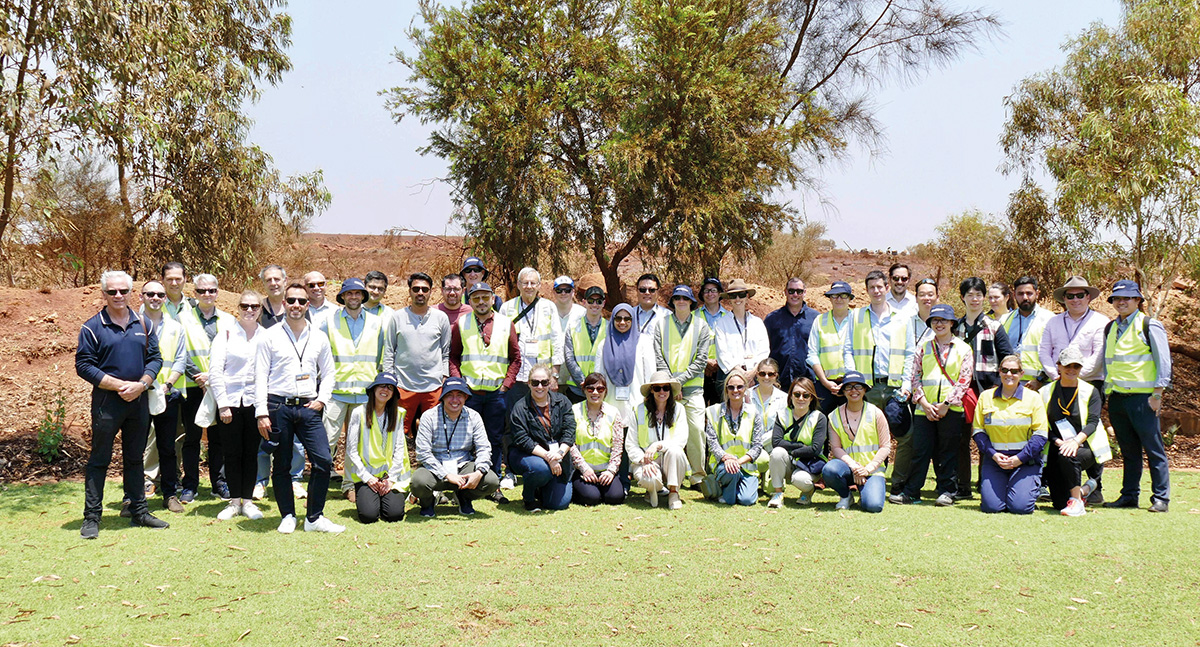
The trip began and ended in Perth and also included a day on the Burrup Peninsula in the Pilbara – the engine room of Western Australia (WA)’s resources economy. Delegates had the opportunity to see the scale of key resources in iron ore, natural gas and ammonia production, as well as to experience the region’s Indigenous cultural heritage.
Back in Perth, WA’s manufacturing strength was highlighted in a site visit to the Australian Marine Complex (AMC) – a flexible, modern facility for multiple users to conduct military and civilian shipbuilding and repair. Delegates also heard presentations from business and government leaders on the state’s decarbonisation plans in action and the range of industries targeted for future growth.
Some of these future industries reflect WA’s strength in natural resources: it has huge opportunities to extract critical minerals needed for decarbonisation – perhaps most notably lithium, of which the state has more than 20 per cent of the world’s reserves. Meanwhile, renewable hydrogen, and carbon capture and storage are also among the focus areas.
Natural gas, in the meantime, likely has a huge role to play during the transition phase, as a less carbon-intensive fuel that can replace coal in particular as a source of industrial and firming power in the medium term while renewables scale up globally.

At the same time, the WA government is also seeking to use its fiscal strength to support a drive toward economic diversity. Some of this diversity will come from existing areas of strength outside the resources space, others will be an evolution of technology and skills derived from the mining sector, and still more will spring from investment in emerging areas.
CONFIDENT OUTLOOK
Setting the scene at a welcome dinner in Perth, WA’s deputy premier and treasurer, Rita Saffioti, highlighted the solid economic foundations built by careful management of the state’s natural endowments. Saffioti said: “Western Australia enjoys some great natural advantages. We have an abundance of natural resources and critical minerals. We have an incredible supply of renewable energy resources due to our beautiful weather. And of course, our time zone – aligned with China, Hong Kong, Singapore, Malaysia and with many parts of Indonesia – makes visiting and doing business in WA very, very different from other parts of the country.”
The state government has placed great store on its management of public sector finances, which Saffioti pointed out has resulted in WA now being the only Australian state with stable triple-A ratings from S&P Global Ratings and Moody’s Investors Service on the back of six consecutive operating surpluses.
This puts the state in a strong position to commit to the investment needed to support its future growth and economic diversification, including its sustainability plans. Saffioti highlighted infrastructure projects including the Metronet expanded public transport system, upgraded port infrastructure – including a new container port in Kwinana in Perth’s south, close to the AMC – new hospitals and Perth’s third desalination plant.
The state government’s perspective is that while transition to a sustainable economy is a substantial task, it is at least as much of an opportunity for WA as it is a challenge. “We are undergoing a huge generational shift and energy is the key,” Saffioti said. “WA, already a global energy exporter, has the opportunity to become a global green energy leader. The world needs lithium, nickel, cobalt and other critical minerals to drive the energy transition – and WA has all these minerals in abundance. We also have the skills, technology and expertise to continue to develop clean energy technology that will see WA lead the world in the transition to net zero greenhouse gas emissions.”
PRIORITY SECTORS
In 2021, the Department of Jobs, Tourism, Science and Innovation (JTSI) published Diversify WA, an economic blueprint for collaboration between government, industry and the community to support the government’s focus on creating secure, quality jobs, growing and diversifying the economy and attracting investment – with a particular eye to
the target of adding 150,000 jobs by mid-2024.
In April 2023, JTSI also released Future State: Accelerating Diversify WA. This document identified priority sectors that combine an existing competitive advantage for WA with potential for future growth. “WA is well positioned to take advantage of the megatrends shaping the future global economy,” Rebecca Brown, director general at JTSI, told conference delegates.
“Diversify WA matches global trends with WA’s unique strengths. It outlines the external-facing priority sectors that the state government has been actively developing to promote diversification, build economic
resilience, create new jobs and ensure WA enjoys a high-quality lifestyle right now and into the future.”
Delegates heard from representatives of WA’s priority sectors: space and cross-sector technologies, renewable hydrogen, critical minerals, oil and gas decommissioning, carbon capture and storage, high-value food and beverages, naval vessels, medical products and digital health, and regional tourism.
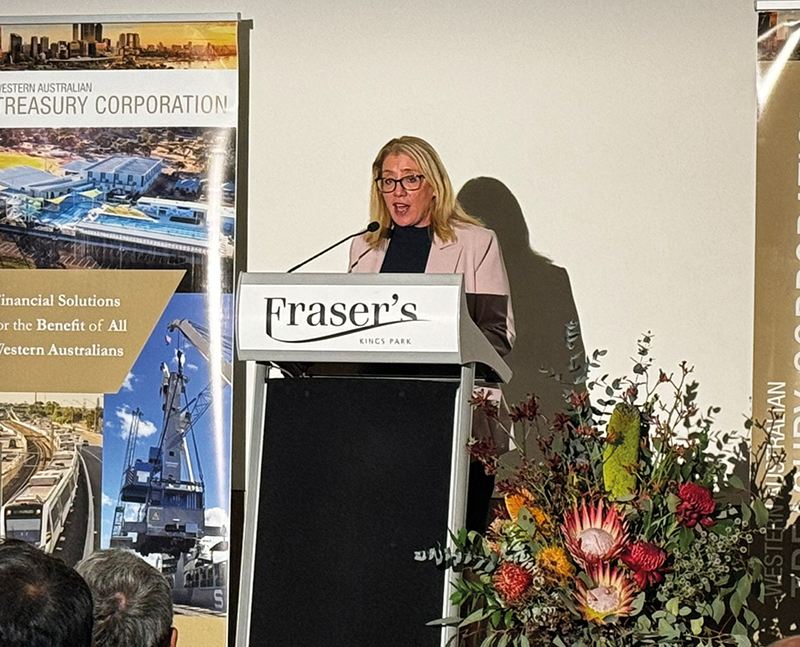



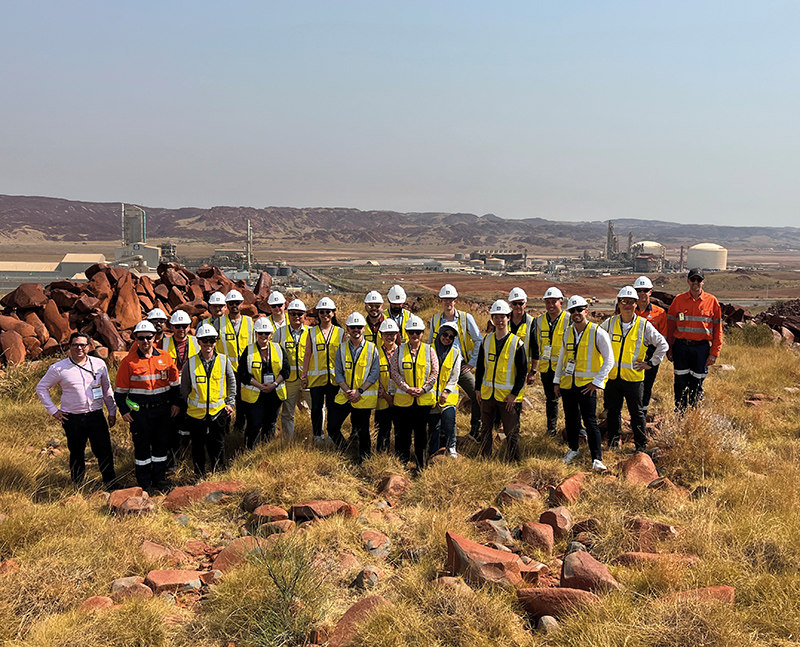
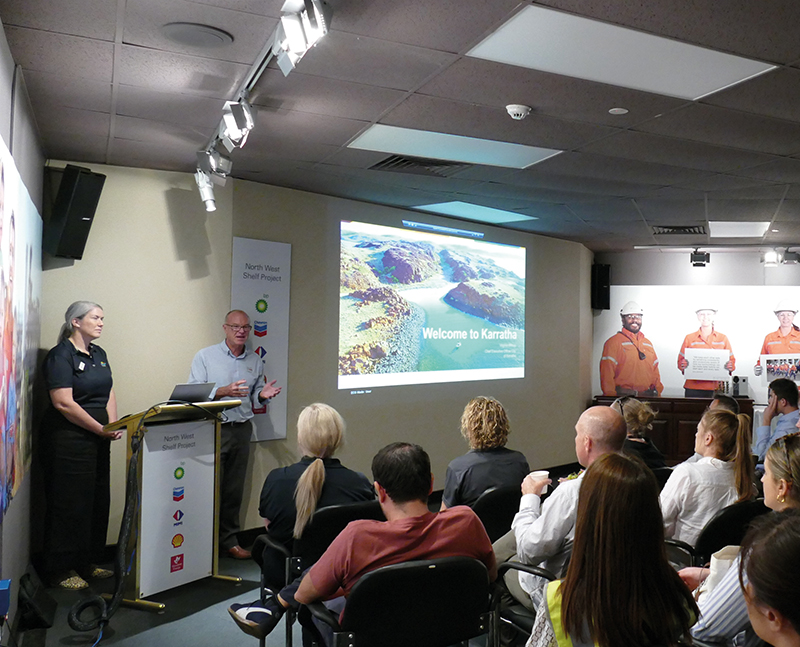
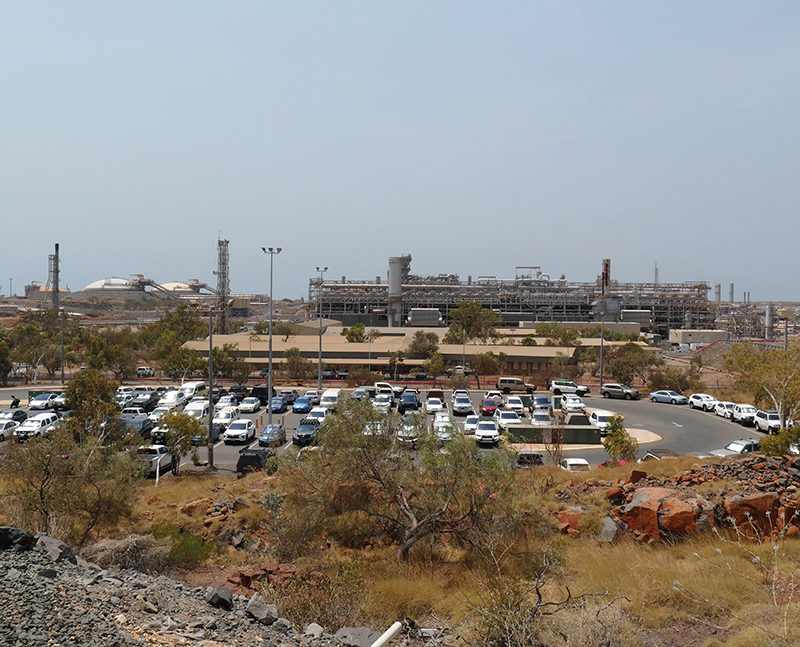
Space and cross-sector technologies provides a good example of how WA can springboard off of its traditional strengths into future industries. Sam Forbes, a director at Fugro who is also heading up the Australian Space Automation and AI Robotics Control Complex (SpAARC), explained how WA’s resources industry is placing the state at the forefront of autonomous technology development.
He said: “The mining sector has for many years deployed centralised operations and mission-control-like facilities, and the military has long deployed a range of autonomous capabilities. These experiences helped us to start on a similar trajectory. We have moved through a series of steps including adding real-time data back to shore from our vessels, then relocating people to a centralised mission operations facility.”
In 2021, Fugro launched its first fully uncrewed surface vessel in the commercial maritime sector. It is currently in operation off the north-west coast of WA, supporting operations in the resources sector with execution all conducted from the centre of Perth – roughly 1,500 kilometres away. “This parallels the next-generation capability we are developing in support of the emerging space sector and through the SpAARC facility,” Forbes told delegates.
A similar theme applies to many of WA’s other sectors of focus. Oil and gas decommissioning, for instance, is a significant and growing requirement of the transition away from fossil fuels. It is a complex task that benefits from skills and proximity – both of which WA offers. When conference delegates visited the AMC, one of the major ongoing projects was the decommissioning of a substantial piece of equipment from the offshore gas extraction industry.
But not every growth area ties back to resources. WA is also a traditional agricultural powerhouse – it is one of the world’s largest grain exporters, for instance, and the agriculture and food sector contributes around A$24 billion (US$16 billion) to the state’s economy annually. There are opportunities for sustainability-driven growth here, too. For instance, Liam O’Connell, executive director, agribusiness, food and trade at WA’s Department of Primary Industries and Regional Development, highlighted the importance of WA-grown canola for use as biofuel in the EU.
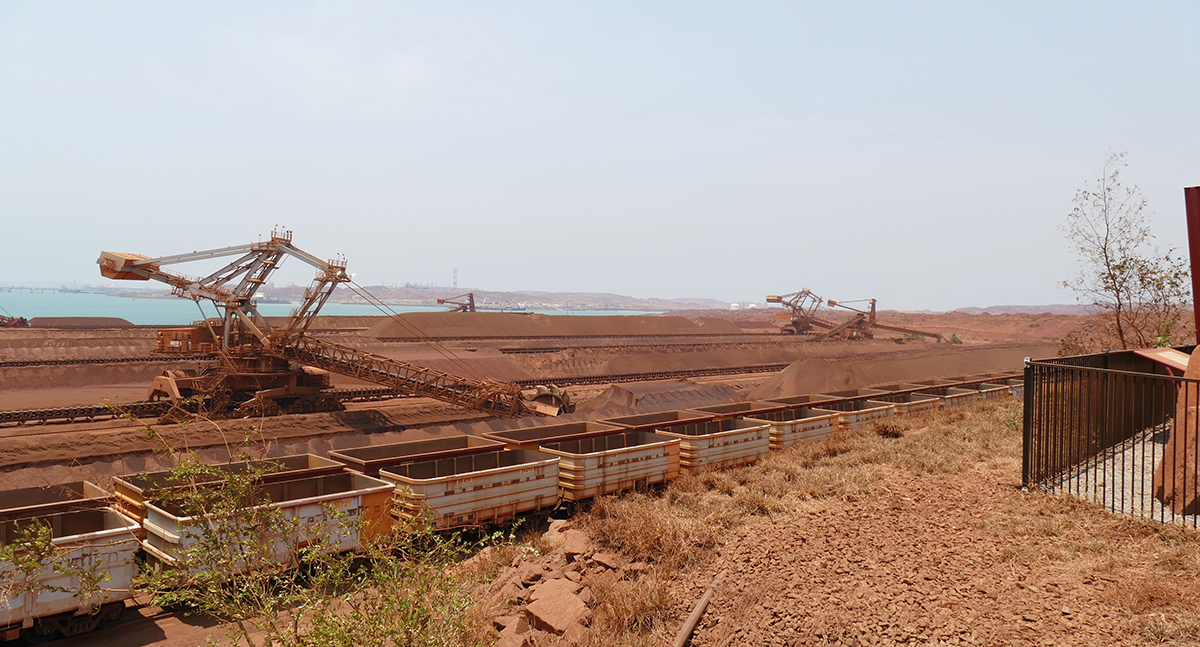
Meanwhile, Dr Tracey Wilkinson, director, stakeholder engagement WA, at MTP Connect – Australia’s life sciences innovation accelerator for medical technologies, biotechnologies and the pharmaceuticals sector – and the Western Australian Life Sciences Innovation Hub – a partnership between the state government, the University of Western Australia and MTPConnect – pointed out that developing novel medical products for the health sector is a fast-growing part of the state economy and a major component of global growth.
“We have a long history of medical research and innovation, and the entrepreneurial spirits required to progress research into reality,” Wilkinson said. “We have a crop of companies and startups building on this legacy… and we also have a growing number of innovative medtech and pharma companies developing sophisticated medical devices, digital health products and therapeutics.”
Building sustainable success in the medical technology field requires investment – and its inclusion as a priority sector in Diversify WA speaks to the state’s strong financial position and the government’s ambition for economic diversification. It is not just about exploiting existing strengths and spinning them off into related fields but it is also about genuine investment in the future economy.
“Like all deep tech sectors, access to capital is key,” Wilkinson added. “Recognising this, the WA government has legislated redeployment of our sovereign wealth fund to invest in health and medical research and innovation. The Future Health Research and Innovation Fund is a A$1.7 billion vehicle, the profits of which are being invested in research and innovation.”
NEW ZEALAND BEGINS ITS CLIMB FROM A DEEPER VALLEY
As challenging as economic conditions in New Zealand have been, market participants speaking at the Commonwealth Bank of Australia Global Markets Conference 2023 are at least somewhat optimistic about what 2024 might bring. The local rate-hiking path has been steeper than Australia’s, however, and the impact has cut more deeply.
New Zealand’s recent experience can be summed up as ‘like Australia’s, but more so’. The Reserve Bank of New Zealand (RBNZ) started hiking earlier and has gone further, leading to a greater impact on household demand and a steeper economic downturn. Similar impacts are coming from the slowdown in China, geopolitical tension and migration. Whether the upswing will also be more pronounced is less clear.
It is not difficult to imagine an improved period ahead for New Zealand, though. The country started the year in the grip of a technical recession, with the economy having delivered two quarters of negative growth between the later part of 2022 and early 2023.
Prevailing economic conditions – a cost-of-living crisis compounded by rapidly rising interest rates that have kept ahead of wages growth – are far from unique to New Zealand. But the local impact has been particularly stark. “There is extraordinary pressure on households,” remarked Nick Tuffley, ASB Bank’s chief economist.

He continued: “We have the stereotypical cost-of-living crisis: very high interest rates, high inflation and wages not keeping up. This has been putting pressure on households and is washing into all retail and housing-related parts of the market. At the same time, there is a background of weakened global growth and softer commodity export prices. Of particular relevance in New Zealand is that the price of dairy products has come down significantly from its post-COVID-19 bounce.”
As with Australia, to date the New Zealand household and SME sectors have adapted to higher interest rates. Steve Lucas, general manager, treasury at ASB Bank, noted that impairments, allowances and provisions on the bank’s balance sheet remain in comfortable territory. For instance, arrears in the agriculture and SME space have “ticked up fractionally but are still well within long-term ranges”.
Looking ahead, Tuffley noted some reasons for optimism. For example, the RBNZ has signalled it is at the end of its rate hike cycle. Tuffley said this has perked up the housing market, which represents a positive marker to suggest better times may not be too far in the future.
Property prices have increased, turnover is tracking upward and it is taking less time to sell property. “RBNZ signalling has reduced a lot of the uncertainty about buying a property and people seem to be more prepared to enter the market,” Tuffley continued. “It is a good sign that we are past the worst of the really weak patch we had late last year and early this.”
A recent change of government could be another positive for New Zealand’s economy, at least at the margin. For example, the new government’s plan to reverse more restrictive tax treatment for residential investment property – put in place in September 2021 – could propel the housing market further.
“We are likely to see some changes that will make property investing more palatable for participants,” Tuffley explained. “The ability to deduct interest rates as an expense was taken away a couple of years ago and dramatically changed the financial sums for property investors. If this is rolled back, we expect there will be more interest in the housing market from investors.”

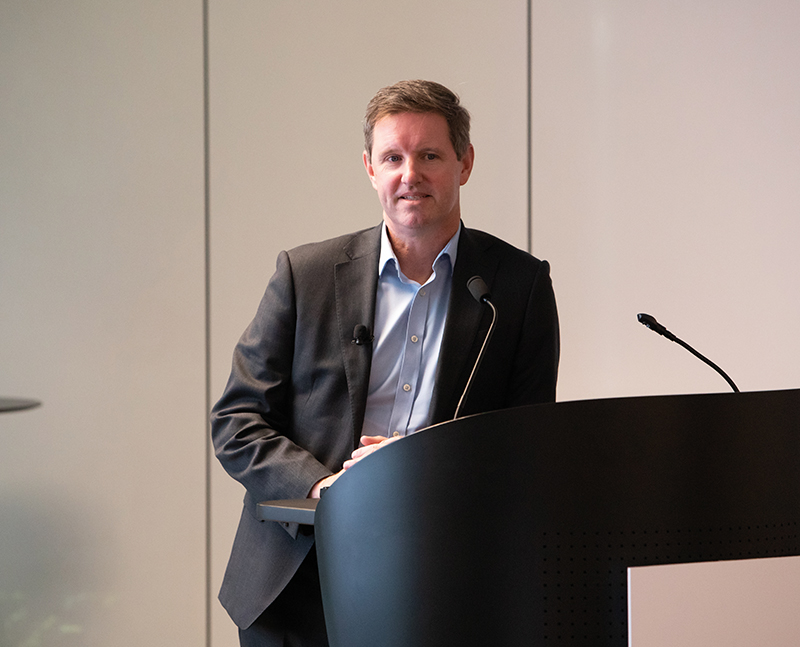
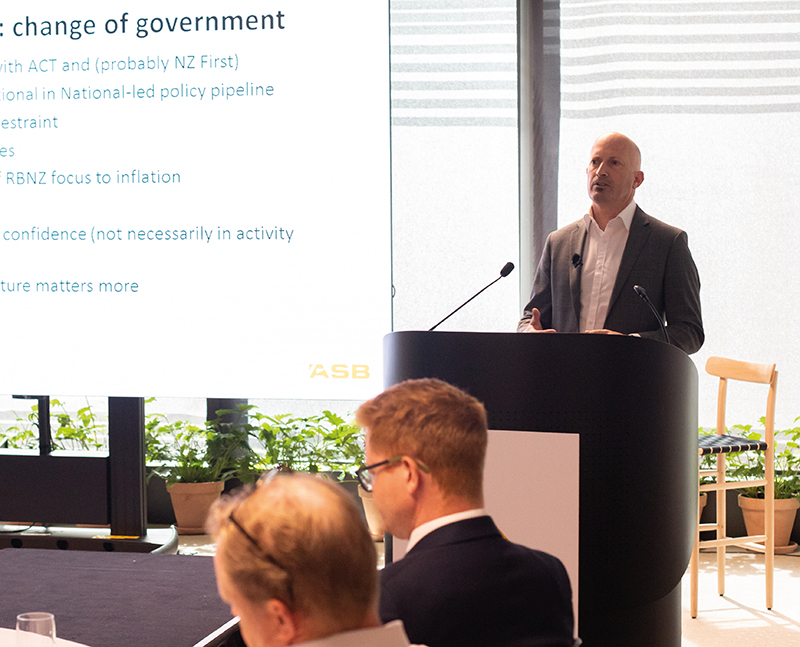
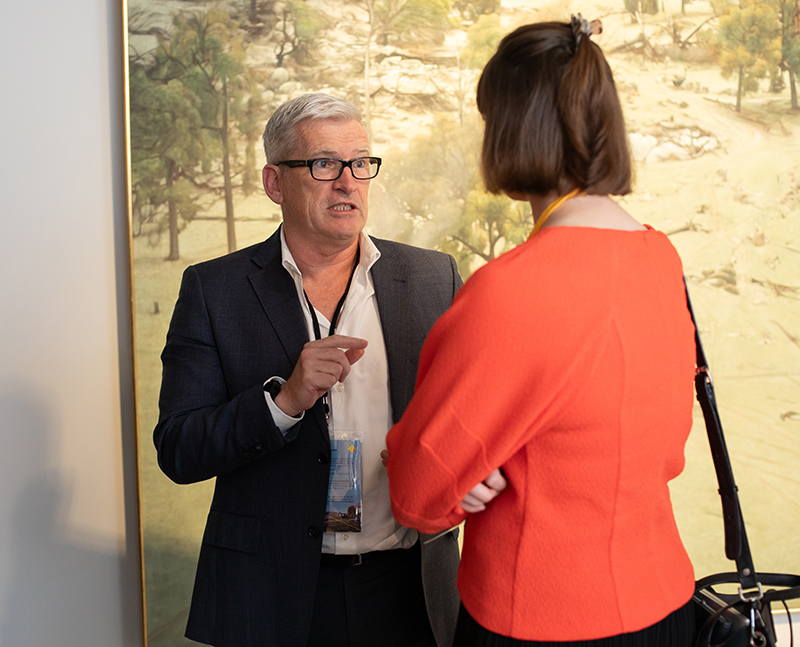
In general, though, Tuffley does not expect any significant economic effects from the new government. “We are unlikely to see anything transformational come through that sends the economy in a different direction,” he said. “The incoming government is very focused on fiscal restraint. It wants to do tax cuts to some degree but it also wants to get the operating balance back into surplus and get on top of debt quickly.”
Tuffley added that the government’s ambition to “slash spending” would be something to watch if not accompanied by effective tax cuts at the appropriate time. “If we have fiscal tightening but not much offset, there is a risk of a fiscal-led domestic slowdown,” he concluded.
New Zealand’s fiscal position looks robust even before the new government’s claims to responsibility are tested by the fiscal outlook. Kim Martin, director, New Zealand Debt Management at the Treasury, pointed out that, even with a significant uplift in Crown debt during the pandemic, the net debt position is expected to peak at just 22.8 per cent of GDP.
Overall, New Zealand’s most prominent risk factors for the next 12 months are likely to be from overseas. If China’s economy continues to stall, commodity prices will lag and there will also be an impact on New Zealand’s tourism industry, Tuffley noted. A general atmosphere of heightened geopolitical risk means expecting the unexpected will be the order of the day.
PEOPLE MOVEMENT
Even putting aside exogenous shocks, Tuffley’s base case is not for a rapid rebound. He noted that per capita GDP has been falling for some time and predicted that it will continue to do so for the remainder of 2023 and into next year. “The economy still has a lot of pressure from high interest rates working their way through. From this point, it will be a gradual recovery,” he said.
In fact, the only reason New Zealand is not currently in negative growth territory is positive net migration: there are roughly two immigrants for every emigrant and the peak net inflow is slightly higher than pre-pandemic. The economic impact has changed, however.
“Usually, people arrive and then go out shopping, buy a house, furnish it – and this tends to drive up inflation,” Tuffley commented. “This time has been quite different. There has been a pronounced impact on labour supply but not an overall demand push. Migration has helped the housing market marginally but has not pushed up consumer spending. The composition of people coming in is trending younger and they are not rushing to buy a big house: they are working and not spending too much. This is assisting with getting on top of domestic inflation.”
What could be better, however, is tourism levels. Unlike Australia, which tends to be a net importer of tourism services, New Zealand relies on more tourism dollars coming into the country than going out. In fact, tourism is one of the country’s largest export sectors. “There has been some recovery in tourism, but it is not back to where it was, which means our export sector has a hole in it. It is a slow process,” Tuffley told delegates.

HIGH-GRADE ISSUERS YEARBOOK 2023
The ultimate guide to Australian and New Zealand government-sector borrowers.

WOMEN IN CAPITAL MARKETS Yearbook 2023
KangaNews's annual yearbook amplifying female voices in the Australian capital market.







